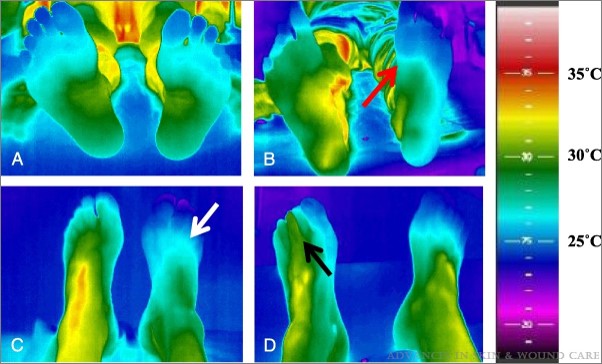Infrared thermography (IRT) is a novel potential noninvasive diagnostic method. It is safe and reliable, allowing for quick evaluation of radiating energy related to skin temperature.20–23 The correlation between body temperature and various diseases has been known for centuries. The core temperature of a healthy person is almost constant (within ± 0.6° C), but skin temperatures can shift substantially depending on the need for and extent of thermoregulation. Vasodilatation and vasoconstriction of skin blood vessels can effectively regulate core temperature because skin acts as an effective heat radiator or insulator depending on the amount of blood flowing through the organ.24 The most common factors known to affect skin temperature and indicate abnormalities are inflammation in the subcutaneous/underlying tissues and changes in blood flow.20–25
Multiple publications suggest that skin temperature variations may be useful for identifying pathologic conditions in diabetic feet,25–27 but few studies have assessed IRT for evaluating PAD without diabetes. This study aimed to clarify the clinical screening or diagnostic potential of IRT compared with conventional noninvasive measurements for PAD.
Common clinical practice for temperature assessment involves manual palpation of the foot. However, temperature changes are typically too small to be reliably determined by hand. These results suggest that IRT could be an effective additional diagnostic tool for PAD given that IRT effectively revealed multiple temperature readings in various parts of the foot. Hot and cold spots in the feet seem to be predictive of the development of ulceration.25,30
So what does IRT add to clinical decision-making? All diagnostic methods have their limitations. Sometimes single-test sensitivity is not high enough to identify significant PAD. In these indefinite cases, IRT results might help clinicians make a definite diagnosis and avoid further invasive investigations. These results showed that although IRT might not be useful as a single screening measurement, it has potential to provide additional information about foot circulation, subclinical infections, and the severity of vascular disease. Further, IRT is a useful tool in prevention, especially for high-risk patients. In the authors’ clinical experience, IRT can reveal subclinical infections and plantar high-pressure areas—cases in which early detection is vital for limb preservation.
Further, implementation of IRT is reasonable in most care settings. This study’s measurements were performed under daily routine conditions in a clinical setting. Given typical circumstances, the IRT pictures were easy to take among other measurements and had a small learning curve; IRT did not require any extra time or cost other than the camera itself.

Copyright © 2020 Wolters Kluwer Health, Inc. All rights reserved.